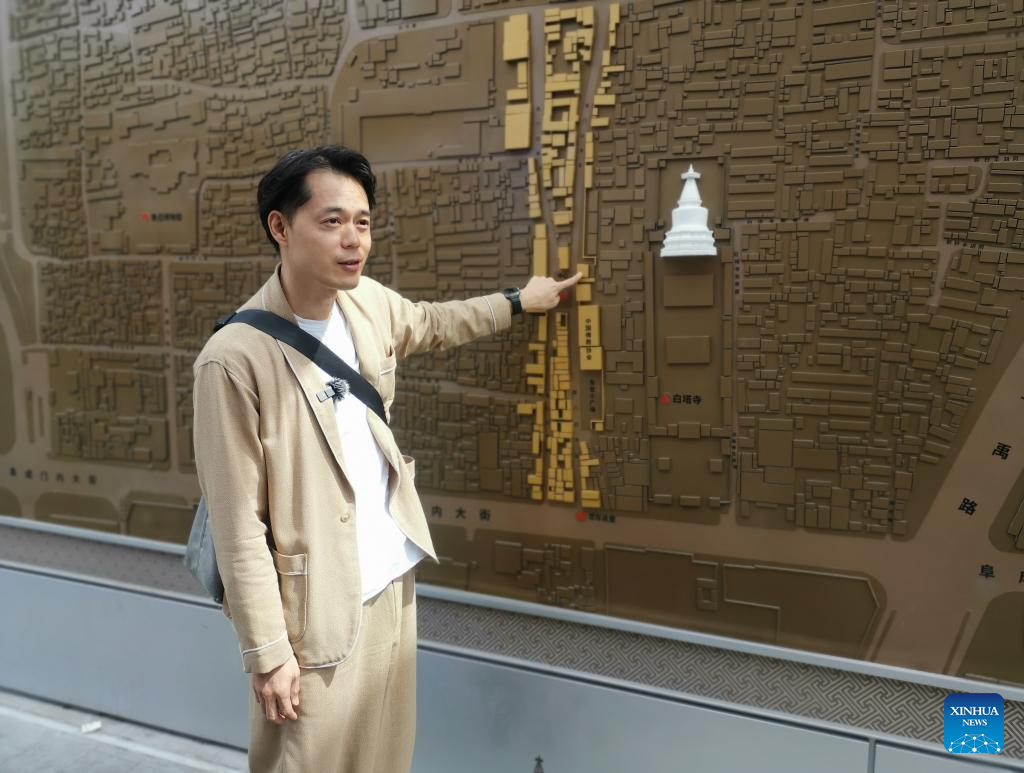
Japanese architect Shuhei Aoyama gives an introduction on a hutong near the centuries-old Miaoying Temple, also known as the White Stupa Temple, in downtown Beijing, capital of China, April 8, 2025. (Xinhua/Wang Xiaopeng)
When Japanese architect Shuhei Aoyama dropped by a bakery near the centuries-old Miaoying Temple, also known as the White Stupa Temple, in downtown Beijing, he was delighted to see his latest project buzzing with people.
With its cozy porch and grey brick walls, the bakery blends seamlessly into the surrounding hutong alleys and courtyard houses of the historical district.
The building's exterior wall features a big mirror, attracting numerous passersby to take photos. Inside, a well-positioned window offers seated diners the perfect view of the iconic white pagoda, a Buddhist structure designed by a Nepalese architect and built in the early Yuan Dynasty (1271-1368).
By skillfully weaving together traditional elements and modern aesthetics, Aoyama has created a space that is at once inviting, artistic, and deeply connected to the city's cultural roots.
"I didn't expect so many customers when designing it," Aoyama told Xinhua in fluent Chinese with a mild smile.
The Japanese architect first visited China as a teenager, and returned in 2005 after earning a master's degree in architecture. Amid Beijing's vibrant architectural boom ahead of the Beijing Olympics in 2008, Aoyama decided to make the city his home.
The next 10 years would see him living in the hutongs, and drawing inspiration from these ancient alleys. In 2014, he co-founded an architectural studio at a Beijing startup hub.
REINVENTING HUTONG LIFE
Aoyama first rose to public attention through a television show in which he transformed aging hutong residential buildings.
One notable project involved an L-shaped house of less than 40 square meters in Dengshikou Hutong. Aoyama reimagined the space into a functional and desirable home, much to the delight of its returning residents.
Having lived in the hutongs himself, Aoyama developed a deep appreciation for the lifestyle. "I realized that in the hutongs, buildings are in constant dialogue with their environment," he explained. But what impressed Aoyama most was the strong sense of community.
"For example, my neighbor's child would wander in and out of my house and into others', and my neighbors would clean the shared courtyard and even help me collect the laundry when it's raining," he said.
"They did this because they believed the shared space was part of their home. In their minds, the entire hutong was home."
To Aoyama, architecture is a vessel for memory, preserving the traces of time and history.
"I don't want to see old neighborhoods turned into museums -- preserved, but empty because people move out when they get the chance. We aim to use modern design to turn them into places people actually want to live in."
By employing new materials and techniques, Aoyama's team has joined the local endeavor in addressing common issues in hutong living: cramped spaces, poor insulation, inadequate bathrooms, and limited ventilation and daylight.
He believes it's vital for a city to keep such diverse communities in the old town where people of different ages and backgrounds can interact with each other.
INSIDER TO CHINA'S ARCHITECTURE
As a Japanese architect based in China, Aoyama has had a unique vantage point on the country's architectural development.
Rather than joining a large global firm, he chose to begin his career with a Japanese company in China. "I felt there was more I could contribute here," he said.
In 2005, the company's projects were mostly mega ones in major cities, such as large commercial complexes and residential buildings. After establishing his studio, Aoyama shifted his focus toward urban renewal: revitalizing old neighborhoods and historical districts nationwide.
Official data showed that from 2019 to 2024, China initiated the renovation of 280,000 old residential communities, benefiting 48 million households and over 120 million people.
More recently, Aoyama's team has taken on rural revitalization projects, transforming traditional countryside homes into guesthouses and boutique hotels.
Aoyama notes that China's architecture industry has become more standardized and professional over the years. "Clients now evaluate firms, domestic and foreign alike, based on their work, philosophy, and values."
With its vast population and many growing cities, China, which now pursues the building of quality homes that are safe, comfortable, eco-friendly, and smart, remains a fertile ground for architectural innovation. "There are still so many opportunities," Aoyama said.
ARCHITECTURE AS CULTURAL BRIDGE
"Architecture is not like selling a product but a creative pursuit," Aoyama remarked. "If I want to design something in Beijing, I need to understand the local climate, culture, terrain, and how people live. The process is a great way to truly get to know a place."
Over the past two decades in China, Aoyama has traveled to every provincial region -- more than many Chinese people. During these trips, he collected not only building materials like ancient bricks that interested him, but also books on local architecture, to better understand the country.
Traveling across borders frequently, he was surprised by how deep the exchanges between China and Japan had gone.
"Twenty years ago, few people around me had been to Japan. Now, many of my Chinese friends have visited, and some know it even better than I do," he said, adding that they also have Chinese clients who asked his team to renovate properties they purchased in Japan, incorporating traditional Chinese courtyard elements into the design.
While pursuing his doctorate at Tsinghua University, Aoyama joined a collaborative project that brought students from both countries together to work and learn. That experience left a lasting impression.
"I hope more young people from China and Japan can connect through architectural projects," he said. "For me, architecture is an important medium for cultural exchange."
 Editor:Qiu Xiaochen
Editor:Qiu Xiaochen